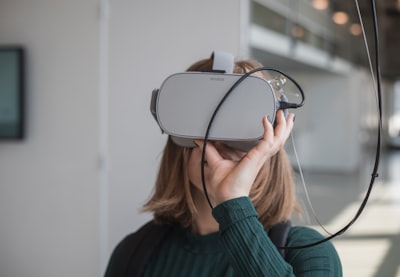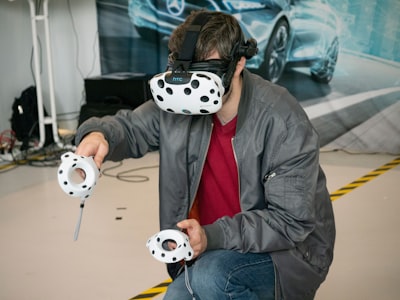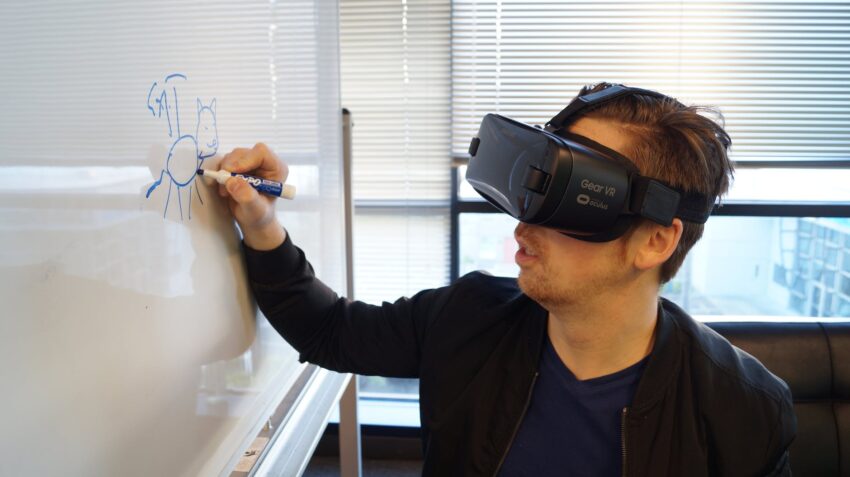How to Create VR
How to Create VR Virtual Reality applications are revolutionizing the gaming industry, providing an immersive experience for gamers worldwide. But VR has much more to offer than just gaming! In this blog, we will explore how VR is being used in marketing, education and training, healthcare, and more. We will also explain the difference between 360-degree videos and interactive VR simulations and help you choose which one is best suited for your needs. Additionally, we will dive into the tools and techniques needed for VR development, including design, prototyping, 3D modeling tools, game engines, PC, and app. Lastly, we will discuss potential challenges slowing down the adoption of VR and whether investing in it is worth it. Are you ready to create your own VR experience? Let’s get started!

Understanding Virtual Reality (VR) Applications
Virtual Reality (VR) applications are widely used in various industries, including gaming, marketing, education, healthcare, and automotive. By immersing users in a simulated environment, VR technology creates interactive and engaging experiences. Users can be transported to different locations or time periods, enhancing user engagement and providing a unique form of entertainment. In the gaming industry, VR offers a great way to create immersive and realistic video games, attracting a wider audience. Additionally, VR applications have found their place in marketing campaigns, allowing companies to showcase their products and services in a virtual world.
In education, VR provides students with a hands-on learning experience, enabling them to explore different subjects in a virtual reality environment. In the healthcare sector, VR is used for training medical professionals, simulating surgical procedures and creating realistic scenarios. Moreover, the automotive industry recognizes VR as a great tool for working with clients, making it possible to develop VR apps for a wide range of human activities. With the advancements in VR technology, the potential for its applications continues to expand, offering new and exciting possibilities for a variety of industries.
This is How to Create VR.

VR in Gaming Graphics
VR in gaming offers an immersive and interactive experience, allowing gamers to step into the game world and interact with it. With VR technology, gaming becomes more realistic, providing a greater sense of presence. VR games provide a new level of immersion, captivating players and often leading to addictive gameplay. The revolution brought by PlayStation VR technology has transformed the way games are played and experienced, introducing a whole new dimension to the gaming industry. From virtual worlds to real-time action, VR gaming on platforms like PlayStation VR is a great way for game developers to create unique and engaging experiences for players.

VR in App Marketing
Virtual reality (VR) has become a powerful tool in the marketing industry, allowing brands to create immersive experiences that deeply engage consumers. By leveraging virtual reality technology, businesses can transport customers into virtual environments where they can interact with products and services. This unique form of marketing leaves a lasting impression on consumers, enhancing brand storytelling and fostering a deeper connection. From showcasing new offerings to creating memorable experiences, VR marketing campaigns offer a great way to captivate audiences and stand out from the competition. By utilizing virtual reality technology, marketers can create a virtual world that captures the attention and interest of a wider audience, offering users more opportunities to interact with video content.
This is How to Create VR.
VR in Education and Training
VR is revolutionizing education and training, offering immersive learning experiences that enhance engagement and retention. Through VR simulations, students can grasp complex concepts in a hands-on manner, bridging the gap between theory and practical application. The technology provides a safe and realistic environment for practicing skills, allowing learners to gain invaluable experience. With VR, educators can create interactive environments that encourage exploration and critical thinking. By incorporating spatial audio and real-world scenarios, VR education programs offer a truly immersive and memorable learning journey. From classroom settings to specialized training programs, VR is transforming the way we educate and equip the workforce.
Healthcare Applications of VR
VR technology has found various applications in the field of healthcare. One such application is in pain management and therapy, where VR is used to create immersive experiences that distract patients from their pain. VR simulations have also been instrumental in surgical training and medical education, providing a realistic environment for practice. Moreover, VR technology has been effective in treating phobias and anxiety disorders by exposing patients to virtual environments that help them confront their fears. Additionally, VR serves as a distraction during medical procedures, easing patient anxiety. Overall, VR therapy has shown promising results in improving patient outcomes and overall well-being.
This is How to Create VR.
Differentiating 360-Degree Videos and Interactive VR Simulations
360-degree videos capture real-world footage from all directions, providing a passive viewing experience. On the other hand, interactive VR simulations allow users to interact with the virtual environment, offering a more engaging and interactive experience. Both 360-degree videos and interactive VR simulations have their unique applications. While 360-degree videos are great for capturing real-world events or creating immersive experiences, interactive VR simulations are ideal for training, gaming, and other interactive experiences. Whether you want to transport your audience to a real-world location or create an interactive virtual world, understanding the differences between these two forms of virtual reality, including Android, is crucial for successful post-production.
Comprehensive Review of 360-Degree Animation Videos
360-degree videos offer a new way to experience events, concerts, and travel destinations. They provide a panoramic view of real-world locations, allowing viewers to feel like they are truly immersed in the environment. These videos are widely used for virtual tours and immersive storytelling, transporting viewers to different places without leaving their seats. Whether viewed on VR headsets, smartphones, or computers, 360-degree videos provide a unique and captivating virtual reality experience. To shoot a 360-degree video panorama, special spherical cameras like 360 Penguin or RICON THETA can be used.
Exploring the World of Interactive VR Footage
Interactive VR simulations offer a more immersive and interactive experience, allowing users to interact with virtual objects and environments. With user input and engagement, these simulations provide a higher level of control and customization, creating a truly interactive virtual reality experience. Whether it’s for training, gaming, or virtual adventures, interactive VR simulations have the ability to transport users into a whole new world.
This is How to Create VR.
Tools and Techniques for VR Development
Designing, prototyping, and creating 3D models are essential aspects of virtual reality (VR) development. Developers utilize a combination of tools and techniques to bring their VR experiences, such as the vr project, to life. By using design and prototyping tools, developers can test and refine their VR experiences, ensuring that they are immersive and realistic. Additionally, a deep understanding of programming languages and software platforms is necessary for VR development. This knowledge allows developers to create interactive and engaging VR applications, including the vr project. With the right tools and techniques, developers can create captivating VR experiences that transport users to a virtual world.
An Overview of Design, Prototyping and 3D Modeling Tools
Designing virtual reality (VR) experiences often requires the use of various tools and techniques. There is a lot of overlap between VR content creation software and game development software. Design tools like Blender and Maya are commonly used for creating 3D models and animations, allowing developers to bring their virtual worlds to life. Prototyping tools such as Unreal Engine and Unity play a crucial role in building interactive VR experiences, enabling developers to test and refine their creations. Additionally, 3D modeling tools are essential for designing realistic virtual environments and objects, enhancing the immersive nature of the VR experience.
This is How to Create VR.
Understanding the Role of Game Engines in Oculus VR
Game engines play a crucial role in VR development, serving as the backbone for creating immersive experiences and realistic environments. Unity, a popular game engine, offers a wide range of features and multi-platform compatibility, making it a preferred choice for VR development. On the other hand, Unreal Engine is known for its stunning graphics and user-friendly interface. These game engines handle rendering, physics, and AI, allowing developers to focus on crafting engaging VR experiences in mixed reality.
Identifying Your Target Audience in Smartphone VR
Identifying your target audience is essential when creating VR experiences for maximum impact. To engage your audience effectively, consider factors such as age, interests, and preferences to tailor the content and interactions specifically for them. Conducting market research provides valuable insights into the needs and expectations of your audience within the VR space. Analyzing user feedback and engagement metrics allows you to refine your VR content and stay up-to-date with evolving audience preferences. By understanding your target audience, you can create captivating VR experiences that captivate their attention and deliver value.
This is How to Create VR.
How to Choose Between Interactive VR and 360-Degree VR Content?
When deciding between interactive VR and 360-degree VR content, consider your project goals and desired level of user engagement. Interactive VR allows users to interact with virtual objects, while 360-degree VR offers a passive viewing experience. Choose the content type that aligns with your objectives and provides the best kind of experience for your target audience.
Factors to Consider when Choosing VR Content Type
When choosing VR content type, there are several factors to consider, including the creation of compelling virtual reality content for your audience. First, think about the intended purpose of your VR content. Whether it’s for entertainment, education, training, or marketing, understanding your goal will help you make the right choice. Next, evaluate the technical capabilities and limitations of the VR platform or device you’re targeting. Additionally, it is important to consider the distribution and reach of your content. You can upload your video to your YouTube / Facebook channel or add it to a dedicated VR channel.
This is How to Create VR.
Programming Languages for VR Development
When it comes to VR development, choosing the right programming language is crucial. C# is a popular choice for Unity, a powerful and flexible framework used in VR development. For those using Unreal Engine, C++ is commonly used, offering high performance and low-level control. JavaScript comes into play for web-based VR experiences with frameworks like A-Frame or Three.js. Python is also an option for scripting, simplifying repetitive tasks and allowing for rapid prototyping. When choosing a programming language, consider your familiarity, project requirements, and the capabilities of your game engine or VR platform.
What are the Potential Challenges Slowing VR Adoption?
Potential challenges are hindering the widespread adoption of VR. High hardware costs, motion sickness, limited content availability, learning curve for development, and misconceptions about VR can all slow down its adoption.
Is Investing in VR Worth It?
Investing in VR can provide a competitive edge as the market continues to grow rapidly. Industries such as gaming, entertainment, education, and healthcare are embracing VR. With advancements in hardware, software, and content creation, investing in VR is worth considering for unique and immersive experiences. Consider your goals, target audience, and resources before making a decision.
Can you make your own VR?
Absolutely! Making your own VR experiences is not as complicated as it may sound. With the right tools and resources, you can create your own VR content and explore endless possibilities.
How much does it cost to create VR?
The cost of creating VR experiences can vary significantly depending on several factors. These include the complexity of the project, the level of interactivity desired, the quality of graphics and sound, and the hardware requirements.
Is creating VR hard?
Creating VR can be a challenging task, but it is not necessarily hard. It requires a combination of technical skills, creativity, and attention to detail. Learning the necessary tools and technologies, understanding the principles of virtual reality design, and overcoming potential obstacles can take time and effort. However, with dedication and practice, anyone with a passion for VR can acquire the skills needed to bring their ideas to life.
What equipment is needed for VR?
To create VR experiences, you will need some essential equipment. The main components include a VR headset, a powerful computer or gaming console, motion controllers, and tracking sensors. The type of equipment you choose will depend on your specific needs and budget. High-end VR headsets like the Oculus Rift or HTC Vive, as well as more affordable options like Google Cardboard, offer top-notch performance and immersive experiences but come at a higher cost.
How long does it take to create a VR experience?
The time it takes to create a VR experience can vary greatly depending on the complexity of the project and the level of detail desired. Simple VR experiences with basic graphics and interactivity can be created in a matter of weeks or even days, while more elaborate projects that involve intricate designs, advanced programming, and immersive storytelling can take several months or even years to complete.
Blog Conclusion
This is How to Create VR experiences requires a deep understanding of the different applications and tools available. Whether you’re developing VR for gaming, marketing, education, or healthcare, it’s important to differentiate between 360-degree videos and interactive VR simulations. Choose the right tools and techniques, such as design and prototyping tools, 3D modeling software, and game engines, to bring your VR vision to life. Identifying your target audience and selecting the appropriate VR content type is crucial for success. Consider the potential challenges that may slow VR adoption, but also weigh the immense opportunities and benefits it can bring. As a game developer, investing in VR can open up new possibilities for immersive and engaging experiences that captivate and delight players.
This is How to Create VR.
Follow on Instagram.

